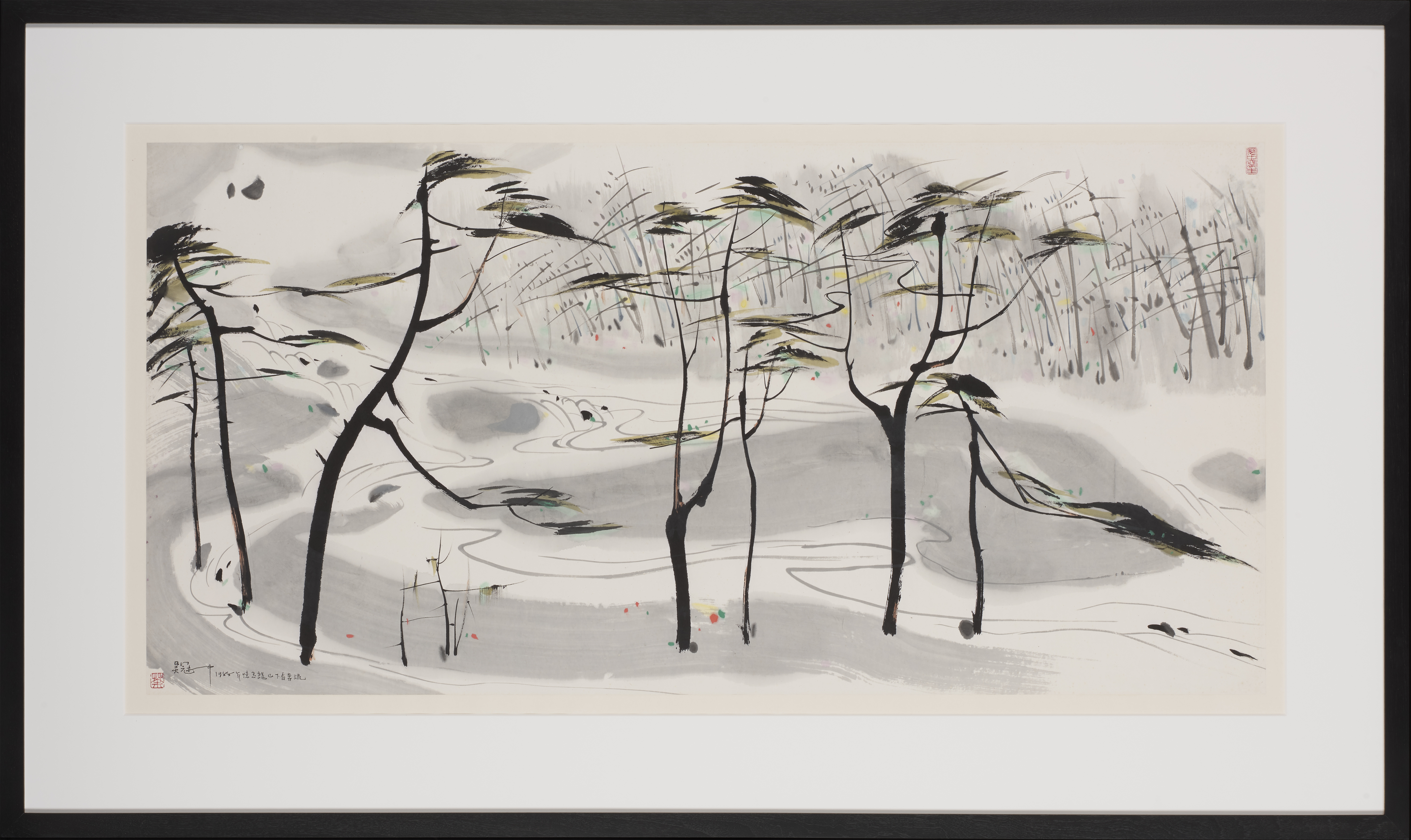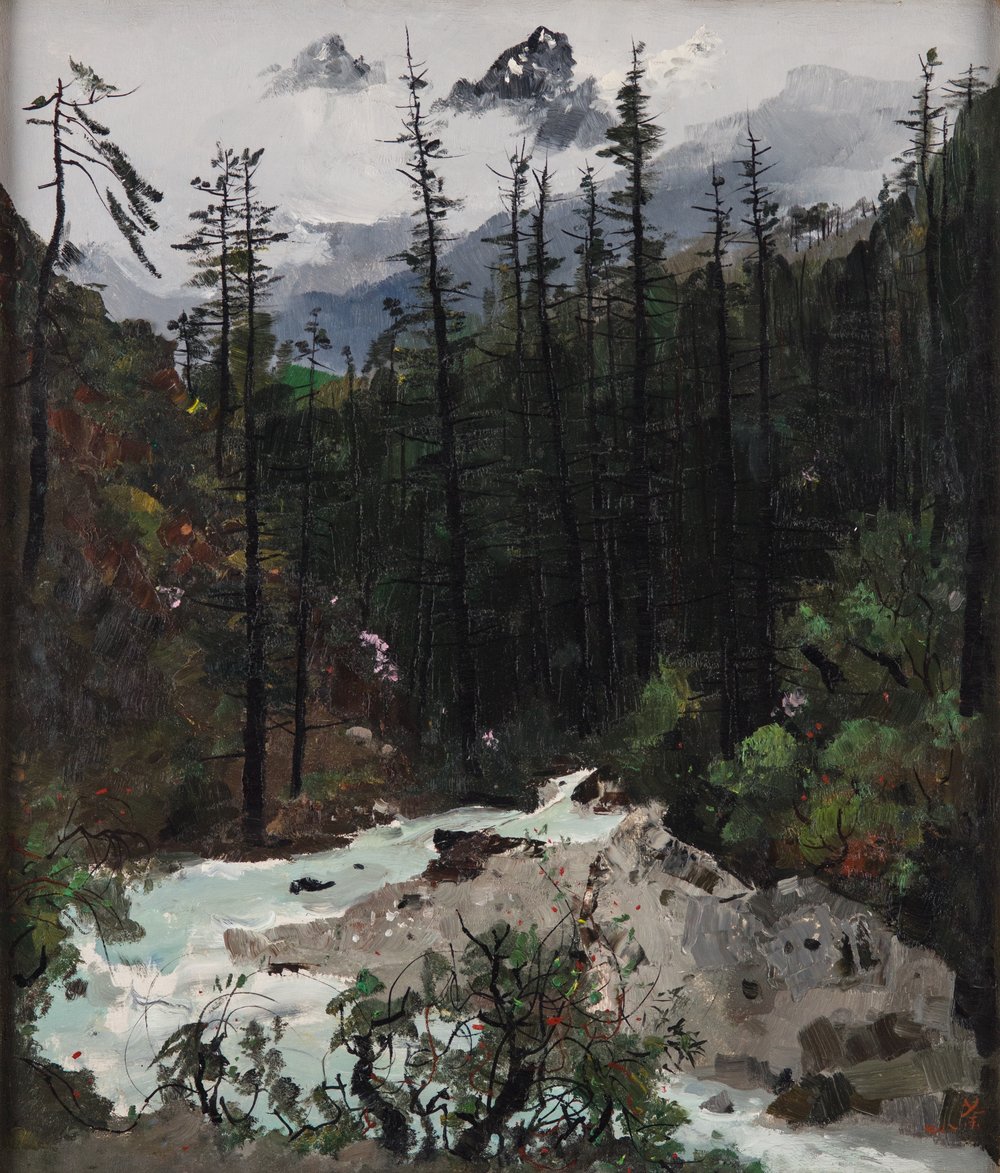The well-loved Chinese ink artist Wu Guanzhong’s writings and paintings are at the centre of an exhibition at the National Gallery Singapore titled Wu Guanzhong: Expressions of Pen & Palette. Having put on two exhibitions of Wu’s works before, this exhibition is yet another expression of the Gallery’s commitment towards finding new ways in which Wu’s works can be presented. One of the show’s curators, Jennifer Lam, kindly walked us through the current exhibition and told us more about one of the show’s main artworks.
Jennifer K. Y. Lam is currently Assistant Curator at the National Galley Singapore. Read in Art History, she also holds a Master in Curating Contemporary Art from the Royal College of Art in London. Within the capacity of the National Gallery Singapore, Jennifer is an active member of the curatorial team who has contributed to the continuous research on art in Singapore and the ink medium, as well as exhibition-projects such as Rediscovering Treasures: Ink Art from the Xiu Hai Lou Collection (2017), (Re)Collect: The Making of Our Art Collection (2018), and Wu Guanzhong: Expressions of Pen & Palette (2018).
Jennifer K. Y. Lam is currently Assistant Curator at the National Galley Singapore. Read in Art History, she also holds a Master in Curating Contemporary Art from the Royal College of Art in London. Within the capacity of the National Gallery Singapore, Jennifer is an active member of the curatorial team who has contributed to the continuous research on art in Singapore and the ink medium, as well as exhibition-projects such as Rediscovering Treasures: Ink Art from the Xiu Hai Lou Collection (2017), (Re)Collect: The Making of Our Art Collection (2018), and Wu Guanzhong: Expressions of Pen & Palette (2018).
¹ Running Stream, Wu Guanzhong
1988, National Gallery Singapore
Credit: National Gallery Singapore
1988, National Gallery Singapore
Credit: National Gallery Singapore

CONTEXT & SIGNIFICANCE
Jennifer Lam (JL): This work is one of the main anchors for this exhibition, Wu Guanzhong: Expressions of Pen & Palette. This work is important because it tells of a love story, if I may, between Wu Guanzhong and the place he depicts, the Yulong Mountains. This was painted in 1988, but Wu had heard of the mountains at least 30 or 40 years ago. However owing to the political turmoil of the time, the entire National Hangzhou Academy of Art was uprooted and scattered. Some of his classmates decided to brave the journey to the mountains, and sent back sketches and postcards of the landscape there. This is how a young Wu Guanzhong, an art student, first came to know and hear about the mountains. We really have to imagine how it would have been like during that time — both the atmosphere and the spirit.
It was only much later, in 1978, that Wu managed to visit the mountains himself. He visited the mountains during the rainy season, and had to wait for quite awhile before the rain cleared. He paints this moment in a small oil painting that we included in a previous exhibition, Wu Guanzhong: A Walk Through Nature. The painting, Jungle at the Foot of the Yulong Mountains, depicts the scenery outside of his motel window. In that painting, the rain and the fog have both cleared to reveal the mountain itself with lush layers of forest in between. He hurriedly grabbed his supplies and went by the river to paint and sketch. The impact of that experience was so great that even ten years later, we see Wu coming back to portraying the mountains again. It’s almost like meeting your first love again, which is why I compared this to a love story of sorts.
Even ten years later, he still paints the mountains incredibly sensitively, and you can see it from the way the ink in Running Stream flows. This is a scene he has in his memory, and you can imagine him running out of his motel after the rain cleared up. The water would have still been flowing rather swiftly, and right in the middle of the painting, you can sort of see this water collecting.
Later when we read his writings, we realised that this scene brought back a lot of memories for Wu himself. He associated this scene with some of the teachings of his mentor, Pan Tianshou. Pan described the process of painting with dry ink. As one paints, the ink becomes more stiff, and Pan likened the hardened ink to steel:
“天天阴雨违蒙,玉龙山不肯露面,我天天打着雨伞在山间观雨景。 【…】 潘天寿老师常题他的焦墨山水:雨后千山铁铸成。湿的树木更如铁铸, 树间飞泉恰似一道白练,黑铁与白练之对照效果强烈,予人坚硬与夫锐之感。”
— 自由 《吴冠中文丛》2
“Rain poured down day after day, the mist obscuring the face of Yulong Mountain […] Every day I walked around the mountain with an umbrella to view the rainy scenes. My teacher, Pan Tianshou, carved an inscription on one of his dry-ink paintings: ‘After rain, a thousand mountains turn into steel’. Wet tree trunks look even more like steel; the flying waterfall among the trees resembles white silk. The contrast between the black steel and the white silk creates a strong impact, producing an impression of fortitude and sharpness.”
— The Waterfall after Rain, 1980s
From The Collected Writings of Wu Guanzhong Volume 2
Wu mimics and references this in Running Stream when he paints these wet tree trunks. This painting is a little ambiguous in that it tends towards abstraction slightly. It isn’t clear what these strokes of ink depict. Are these wet leaves that are hanging off the edge of the branches? But what we can be sure of is how the painting flows from from the upper left corner to the bottom right.
² Jungle at the Foot of the Yulong Mountains, Wu Guanzhong
1978, National Gallery Singapore
Credit: National Gallery Singapore
1978, National Gallery Singapore
Credit: National Gallery Singapore

PROVENANCE
JL: This painting, Running Stream, was donated to the National Gallery Singapore in 2017. The donors acquired this work many years ago, and Wu Guanzhong himself made multiple trips to Singapore in the late 80’s. The donors were moved by the amount of research that went into a previous exhibition by the gallery, Wu Guanzhong: Beauty Beyond Form. Through the exhibition, the donors learnt about Wu’s connection to both Singapore and the National Gallery itself, and they agreed it was time to share this work with a larger audience. As such, they kindly donated this work to the gallery.
When the work first came into the National Gallery’s collection, it was not in great condition. A common problem that plagues ink paintings and works on paper in Singapore and Southeast Asia is the region’s humid climate. The work was covered in yellow spots, in a process we call foxing, and had to be treated. This exhibition marks the painting’s first post-treatment public presentation, in its fresh and new state. When the donors saw the treated painting, they were incredibly delighted to see the work looking like how it did when they first purchased it.
³ Running Stream, Wu Guanzhong
1988, Wu Guanzhong: Expressions of Pen & Palette Installation View at National Gallery Singapore
Photography by National Gallery Singapore
⁴ Wu Guanzhong: Expressions of Pen & Palette
Installation View at National Gallery Singapore
Photography by National Gallery Singapore
1988, Wu Guanzhong: Expressions of Pen & Palette Installation View at National Gallery Singapore
Photography by National Gallery Singapore
⁴ Wu Guanzhong: Expressions of Pen & Palette
Installation View at National Gallery Singapore
Photography by National Gallery Singapore


PAIRING WORDS WITH PAINTINGS
JL: During the process of researching and conceptualising this exhibition, we came across these little moments within Wu Guanzhong’s artworks. It wasn’t an easy task because the Gallery has done two previous exhibitions on Wu’s works. The first exhibition, Wu Guanzhong: Beauty Beyond Form, was a large, chronological survey of Wu’s works. The second exhibition we did was Wu Guanzhong: A Walk through Nature.
We always keep in mind the different audiences and types of visitors that come into the Gallery. As such, our exhibitions can’t be too abstract or distant for our viewers. We need to allow for points of connections to be drawn between the audiences and the artworks that are being shown. At the same time, we’re also aware that we also have to cater to audiences who might be very familiar with Wu Guanzhong and his works. These viewers might have seen the previous two exhibitions as well. The question for us then is how can we bring something new or a fresh perspective to the table? That was why we decided to take a risk by taking on this curatorial style. Here, we’ve paired Wu’s works up with quotations and texts.
Wu was a prolific writer, so the process of picking out these texts was tedious. We spoke with Wu’s son, who resides in Singapore now, and he helped us to narrow the scope of our research down. The eventual text selection was the result of a lot of reading, typing out quotes, and going back and forth between all these texts that Wu wrote. There are so many ways in which his writings could have been paired up with his work. Wu wrote autobiographically, factually and poetically; so we sought to strike a balance between all of these three tones. If we picked out too many autobiographical or factual texts, the overall tone of the exhibition might become rather dry. However, these texts help to foreground the historical and social context of the time Wu was working in. We have a copy of all of his texts in our Resource Centre as well for visitors to look through as well.
CURATING AND DESIGNING THE EXHIBITION
JL: We’ve been very meticulous about the amount of space in the galleries, the colour scheme used, and even the sort of chairs that are placed within the gallery. We wanted to create an immersive experience for the visitor, where it would seem as if one was walking through the mind or the emotional headspace of Wu Guanzhong himself.
Whilst curating this exhibition, we were careful to include several layers to the experience for various visitors as well. For those who prefer exploring exhibitions on their own terms, we’ve allowed them the space and the seating areas for them to do just that. We also provide visitors with audio guides for this exhibition, which allows for a personal experience even without an in-person curator or docent-led tour. In our other galleries, we usually have a 70-word to 130-word long label where we expand on the artwork in focus. We wanted to minimise confusion and the amount of text in the exhibition space, and that has led to an increase in the usage of audio guides. For those who prefer hard-copy brochures, we have curatorial notes included on newspaper stands in the exhibition space as well. Included in these notes are lengthier descriptions and timelines. We wanted to create a contemplative environment, which is important for the appreciation of ink paintings, and made sure that this was included in the our exhibition design briefs.
Wu Guanzhong: Expressions of Pen & Palette is now open at National Gallery Singapore.
The exhibition will run until 29 September 2019.
More information regarding the exhibition can be found here.
The exhibition will run until 29 September 2019.
More information regarding the exhibition can be found here.
